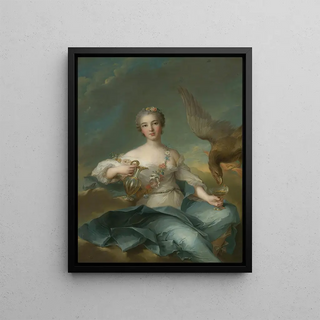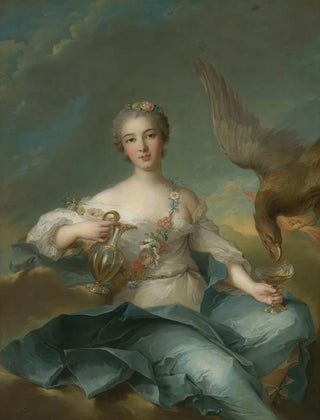Art print | The Duchess of Chartres in the role of Hébé - Jean-Marc Nattier


View from behind

Frame (optional)
In the vast panorama of 18th-century French art, the art print "The Duchess of Chartres in the role of Hébé" by Jean-Marc Nattier stands out for its delicacy and elegance. This painting, which captures the very essence of femininity and grace, immerses us in a universe where mythology blends with the daily reality of the court. The duchess, depicted with the features of the goddess Hébé, embodies both ideal beauty and high social status, thus uniting the sublime and the profane in a harmonious composition. Through this work, Nattier invites us to explore the subtleties of aristocratic life while paying homage to the classical culture that permeates his era.
Style and uniqueness of the work
Nattier's style is characterized by unparalleled finesse, both in the choice of colors and in the representation of textures. In "The Duchess of Chartres in the role of Hébé," pastel tones blend with an airy lightness, creating a dreamlike atmosphere. The drapery of the duchess's garment, delicately painted, seems to almost float, while her gaze, both gentle and penetrating, captures the viewer's attention. Nattier excels in portrait art, but he goes beyond mere physical representation; he manages to seize the soul of his model, translating her emotions and her status. The duchess's pose, rising with dignity, evokes the grace of mythological figures while asserting her own identity. This fusion of the sacred and the profane is one of the artist's hallmarks, who succeeds in turning each portrait into a true ode to beauty.
The artist and his influence
Jean-Marc Nattier, born in 1685, is one of the most prominent painters of his time, recognized for his portraits of French high society. Influenced by masters such as Antoine Watteau and François Boucher, Nattier develops a style that is uniquely his own, blending elegance and intimacy. His work is deeply rooted in the cultural context

Matte finish

View from behind

Frame (optional)
In the vast panorama of 18th-century French art, the art print "The Duchess of Chartres in the role of Hébé" by Jean-Marc Nattier stands out for its delicacy and elegance. This painting, which captures the very essence of femininity and grace, immerses us in a universe where mythology blends with the daily reality of the court. The duchess, depicted with the features of the goddess Hébé, embodies both ideal beauty and high social status, thus uniting the sublime and the profane in a harmonious composition. Through this work, Nattier invites us to explore the subtleties of aristocratic life while paying homage to the classical culture that permeates his era.
Style and uniqueness of the work
Nattier's style is characterized by unparalleled finesse, both in the choice of colors and in the representation of textures. In "The Duchess of Chartres in the role of Hébé," pastel tones blend with an airy lightness, creating a dreamlike atmosphere. The drapery of the duchess's garment, delicately painted, seems to almost float, while her gaze, both gentle and penetrating, captures the viewer's attention. Nattier excels in portrait art, but he goes beyond mere physical representation; he manages to seize the soul of his model, translating her emotions and her status. The duchess's pose, rising with dignity, evokes the grace of mythological figures while asserting her own identity. This fusion of the sacred and the profane is one of the artist's hallmarks, who succeeds in turning each portrait into a true ode to beauty.
The artist and his influence
Jean-Marc Nattier, born in 1685, is one of the most prominent painters of his time, recognized for his portraits of French high society. Influenced by masters such as Antoine Watteau and François Boucher, Nattier develops a style that is uniquely his own, blending elegance and intimacy. His work is deeply rooted in the cultural context






